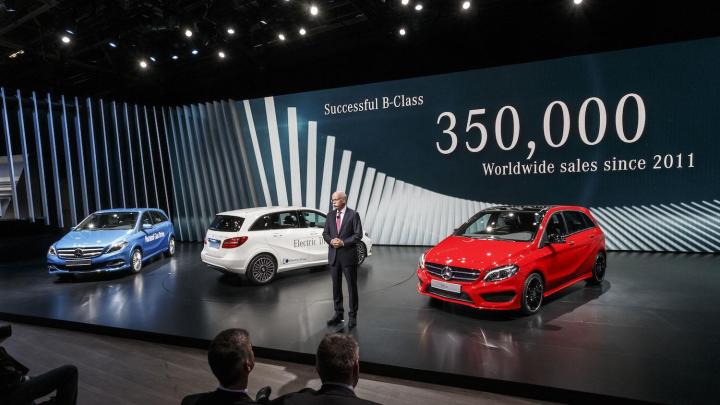
A refreshed front fascia differentiates the newest B-Class from the current, second-generation car that debuted for the 2012 model year. The lower section of the new front bumper has a more upright appearance, and a new grille insert includes two louvers instead of three. Daytime running lights are now integrated into the headlights, with LED headlights available as optional equipment for the first time.

The rear bumper is updated, too, with new lines and trimmed with a subtle chrome strip.
Newly available and improved features bolster the B-Class’s luxury-car credentials. These include a bigger infotainment display, available proximity key with push-button start, a more robust collision prevention system, a standard driver attention monitor and the latest in Mercedes-Benz connectivity.
Related: Mercedes-Benz B-Class Electric Drive first drive
Keen on giving its B-Class customers access to more personalization of their vehicles, the refreshed model lineup offers three new trim lines called Style, Urban and AMG Line. Style brings perhaps the most elegant and understated look. Urban trim is sportier, with twin chrome exhaust tips for the exterior and, inside, contrasting stitching and a steering wheel wrapped in perforated leather. AMG Line is the top trim and also the boldest. A lowered suspension, 18-inch wheels hiding perforated brake rotors, synthetic leather seats with microfiber inserts and plenty of contrasting red stitching complete its look.

On top of these, buyers can choose from three additional personalization packages: Night, Exclusive and AMG Exclusive.
Compared to the relatively simple array of trim choices, the powertrain options for the B-Class are dizzying. The big news from Paris is available all-wheel drive. The B 220 4MATIC is the only model in the range to include it as standard equipment, but the 4MATIC setup can also be specified for the diesel-powered B 220 CDI and B 250 CDI as well as the gas-powered B 250.
For those that are content with front-wheel drive, Mercedes offers several more diesel and gas engine options, from the fuel-sipping B 180 CDI BlueEfficiency to the 211-horsepower B 250. Further, the B-Class Electric Drive and B 200 Natural Gas Drive will provide alternative-fuel options in the compact luxury segment upon going on sale early next month.
Like so many vehicles on display in Paris, the latest Mercedes-Benz B-Class causes American drivers to pine for a wider array of model and powertrain options here at home.


